|
"All that is known
of preceramic projectile points in Belize has been learned over the past
14 years (1979-1993)
through the efforts of the Belize Archaeological Reconnaissance and the
Colha Project Regional Survey."--------1993,
Thomas C. Kelly, "Preceramic Projectile Point Typology In Belize,"
Ancient Mesoamerica, Vol. 4, No. 2, p. 205.
"The
Belize Archaic begins with the start of the Holocene epoch at
approximately 8000 B.C., although there is little information of human
activity until ca. 3400 B.C."----2006,
Jon C. Lohse, Jaime Awe, Cameron Griffith, Robert M. Rosenwig, & Fred
Valdez, Jr., "Preceramic Occupations In Belize: Updating The
Paleoindian And Archaic Record," Latin American Antiquity, Vol.
17, No. 2, p. 216.
"Clearly, the most important research issue for the Archaic in Belize is
better defining the long time span represented in this period. No
absolute dates are available until ca. 3400 B.C., leaving close to 5,000
calendar years uncharted from the end of the Paleoindian period (itself
also undated by absolute means)."----2006,
Jon C. Lohse, Jaime Awe, Cameron Griffith, Robert M. Rosenwig, & Fred
Valdez, Jr., "Preceramic Occupations In Belize: Updating The
Paleoindian And Archaic Record," Latin American Antiquity, Vol.
17, No. 2, p. 221.
"In the more environmentally productive lowlands
(in Mesoamerica),
Archaic period sites are known from the Pacific and Gulf of Mexico
coastal plains as well as in Belize. For a number of different reasons,
though, it is difficult to piece together a coherent picture of change
over the thousands of years of the Archaic period in most of the
lowlands. Generally, the number of known sites is very small"---------1997,
Stephen A. Kowalewski, "Ancient Mesoamerica: A Comparison Of Change
In Three Regions," p. 39.
"The Archaic is the base on which the Formative
stage of Mesoamerica culture was built, when village agriculture became
dominant."------2010, Susan Toby Evans &
David L. Webster "Archaeology Of Ancient Mexico And Central
America," p. 33.
"The Archaic Period (7000 to 1500 B.C.) in the general
Mesoamerican chronology refers to the time interval between when
prehistoric people relied completely upon wild plants and animals in the
preceding Paleoindian Period to when farming was of utmost importance,
beginning in the subsequent Formative Period."----1996,
Brian M. Fagan (Editor in Chief), " The
Oxford Companion To Archaeology, p. 442.
"This
cultural stage (Archaic Period)
followed the cessation of Paleoindian hunting of now-extinct Pleistocene
animals and preceded the Formative period when agriculture, village
life, and pottery began around 2000 B.C. in Mesoamerica and Central
America."----1996, Brian M. Fagan (Editor
in Chief), " The Oxford Companion To Archaeology, p. 30.

LOWE & SAWMILL POINTS
NORTHERN BELIZE
LATE ARCHAIC
The twelve Lowe and Sawmill points, identified
in this report, were found in northern Belize. They
represent fairly rare examples of projectile points from the Late Archaic
period in this area of Mesoamerica. Five of these points were described
and illustrated in 1993 by Kelly in an article called "Preceramic
Projectile Point Typology In Belize." He states in his report that
"Sufficient numbers of preceramic projectile points have now been found
in Belize to define two morphologically distinct projectile point types,
Lowe and Sawmill." Archaeologists have only recently, in the last
three decades, begun to develop general ideas and theories about what
types of tools people were using during the Archaic period in Belize. |
|
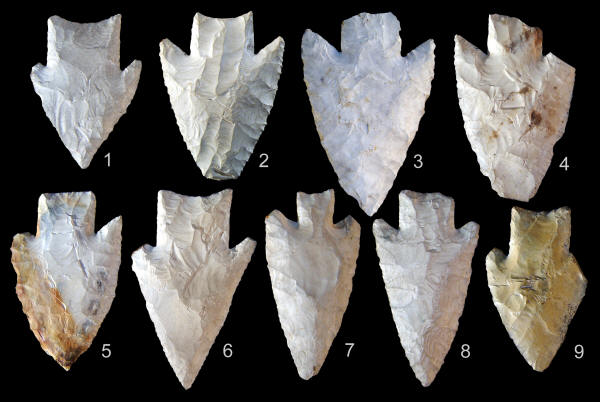
CLICK ON PICTURE FOR LARGER IMAGE
LOWE POINTS
LATE ARCHAIC
NORTHERN BELIZE
All of the points illustrated in this
picture are reported to be from Belize and fit the typological
definition of Lowe points. Kelly's type description of Lowe points
in 1993 was done with a very few examples. In fact, one account
reports there were only 15 known examples in the year 2000. In the
above picture, numbers 1, 2, 5, &
6 were illustrated in Kelly's 1993 description of Lowe points.
Numbers 1, 2 & 6 are reported to have been found on the Lowe Ranch,
where the name for this point type originates.
There are three consistent and overlapping radiocarbon
dates that may date Lowe points (Kelly, 1993). Two samples of
charcoal from the Ladyville 1 site and another from the Pulltrouser
Swamp site were the location sources. Two Lowe points were found
within a 5m radius of the hearth where the first sample was taken at
Ladyville 1. Only one Lowe point was found on the Pulltrouser Swamp
site. Kelly suggests a tentative (not definite) date for Lowe points
at 4500 to 3900 years ago.
Lowe points are curiously similar, in some ways, to the very
much older Hardin Barbed points that occur more than 2,000 miles
north of Belize in the U.S. They are both resharpened by beveling
the edges and the stem edges are ground. Many Hardin Barbed points
also have sharp serrated edges, a similar stem design, wide angled
barbs, and can be thick heavy-duty
points. But they are
typologically different from Lowe points. Most of the points
illustrated here have fairly long end-thinning flakes. In fact,
Kelly describes them as "flake scars that are indistinguishable from
flute scars." Although not many Lowe points have been found, they
seem to tend towards massive barbs, very wide blades and straight
parallel sided stems. Kelly describes Lowe points as resharpened
with parallel "oblique" flaking that leaves sharp serrated edges but
oblique angle flaking does not appear on all of them.
Most examples of Lowe points are heavily patinated with
off-white and yellow colors. Freshly broken points show the
patination continues through the center, indicating a probable greater age than the area's more recent Maya
culture stone
tools.
The Lowe points illustrated here are made of Colha chert. The longest point, in
the second row, measures 3 3/4 inches (9.5 cm) long. Its massive
stem measures 1 3/8 inches (3.5 cm) wide. The widest point in this
group measures 2 3/8 inches (6 cm) wide. Three of the
points also have impact fracture damage on their points (distal
ends). |
|
|
The Archaic period in Mesoamerica lasted a very long
time. It begins when people change from a nomadic hunting and gathering
way of life to a more localized and specialized way of acquiring food. A
trend towards the development of primitive horticultural skills and
fixed settlements are the two great transformations that occur during
the Archaic period. A precise timeframe for this period in Mesoamerica,
and particularly in Belize, is still a little mysterious. Some papers
place the beginning of the Archaic period as early as 11,000 years ago
and others as late as 7,000 years ago. But a good current frame of
reference (Lohse, 2006) suggests a date of 9,000 years ago
for the beginning of the Archaic period in Belize. |
|

SAWMILL POINTS
LOWE RANCH
NORTHERN BELIZE
Both of these points are described in Kelly's 1993 paper on
projectile point typology in Belize. They are reported to have been
found on the Lowe Ranch in northern Belize. Sawmill points are
unique to Belize. Their most striking feature is the fine parallel
oblique pressure flaking and "fluted" stems. Sawmill points have
expanding stems that are ground and concave. Only one Sawmill point
is reported to have been found in situ during excavation. Kelly
reports one point found on the Ladyville 1 site that was located 14
inches (35 cm) below the surface and 8 5/8 inches (22 cm) above
sterile gray clay. No other artifacts were found directly next to
the Ladyville Sawmill point. However, a Lowe point was found about 2
meters away. Delicately flaked end-scrapers are also reported to
have been found with Sawmill points. Based on observations of slight
differences in patination, Kelly suggested in his report that Lowe
points may be older than Sawmill points. Both of these points are
made of Colha chert and the point on the right measures 3 3/16
inches (8.1 cm) long.
The point on the left was complete when it was illustrated in
Kelly's report but apparently lost its tip sometime later with a
fresh break. The point on the right is shown in Kelly's report with
its tip missing but not with the broken and reglued piece, which may
also have broken sometime after his report. They seem to have had
rough handling after the report was done. |
|
|
The end of the Archaic period in Belize is
defined as the beginning of agriculture, when people began to rely more
on plants for food. The main artifact evidence for this period is the
appearance of ceramics. A recent estimated
time-frame for the end of the Archaic in Belize is 3,900 years ago (Lohse,
2006). At present. a good estimated range of time for the Archaic period in
Belize is between 9,000 and 3,900 years ago, a 5,100 year span-of-time. |
|
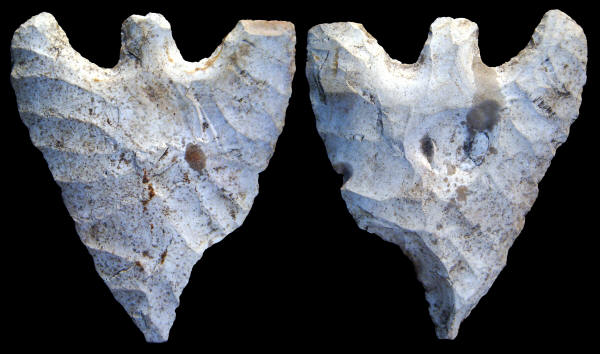
CLICK ON PICTURE FOR LARGER IMAGE
SAWMILL POINT
LATE ARCHAIC
NORTHERN BELIZE
This point is very similar to a point that
is illustrated in Kelly's report and referred to as an aberrant
point. In-other-words, unusual, untypical or uncommon. But he still
suggests it might be a reworked Sawmill point. Although the stem is
small and contracting, it is thinned on one side with one long
narrow flake removal which is a common trait of Sawmill points. The
edges are also resharpened with parallel oblique flaking. Even
though the width of this point is wider by 3/16 inch (5 mm) than the
longest Sawmill point found so far, it still may fall within the
Sawmill type as more of these points are recorded.
The damaged area on the edge near the tip of the point may
indicate it was used as a projectile, as Sawmill points are thought
to have been used. The broken area was retouched in a way that would
have made it once-again usable as a projectile point. One side of
this point (right side) also has what appears to be a fairly deep
round pot-lid type of flake removal which usually occurs with heat,
as could happen in a brush fire, but there is no sign of heating on
the stone. This point is made of Colha chert and it measures 2 5/16
inches (5.9 cm) long and 1 15/16 inches (4.9 cm) wide. |
|
|
Only two types of Archaic projectile points
have been reliably defined in Belize. Both of them "presently" date to
the Late Archaic period. They were named Lowe and Sawmill points by
Kelly in 1993. Both are distinctly different from the other and they
seem to be unique to northern and western Belize. |
|
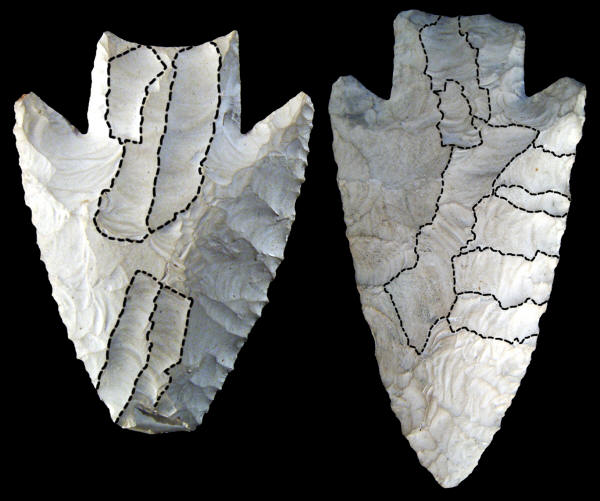
LOWE POINTS---FLAKING PATTERN
LATE ARCHAIC
NORTHERN BELIZE
Both of these Lowe points exhibit "the
unique" long and narrow flaking pattern that represents one of the
diagnostic traits of Lowe points. It is interesting that the flakes
are long enough and wide enough to suggest that some of them may
have been removed indirectly. This would be considered as Paleo and
Early Archaic projectile point production technology in the western
U.S. The fact that Lowe points are considered Late Archaic in Belize
is very interesting. There is undoubtedly much more to learn about
Paleo and Early Archaic lithic technology in this region of
Mesoamerica. The point on the right measures 3 5/8 inches (9.2 cm)
long. |
|
|
Lowe points were first illustrated and described in Kelly's 1993
report on "Preceramic Projectile Point Typology In Belize." They were
named after the Lowe Ranch where several examples were first reported.
"Classic" examples of Lowe points have sharply defined, massive and widely angled barbs. The
stems are ground on the edges and the stems also tend to be very large
and parallel sided and straight to concave on the basal ends. The
cutting edges are beveled from resharpening and they are often sharp
and
serrated. Some examples
were resharpened with parallel oblique flaking. Their most interesting
diagnostic trait are end thinning flake removals. The stems are
thinned from the base in a way that Kelly (1993) described as
"flake scars that are indistinguishable
from flute scars." Lowe points
are massive heavy duty beveled points that some suggest were probably
only used as knives. But it's very likely they were used for both
projectiles and knives. Many of them do have point impact damage. |
|
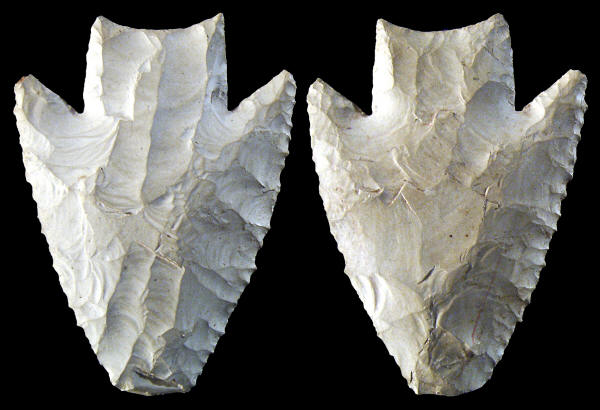
CLICK ON PICTURE FOR LARGER IMAGE
LOWE "TYPE" POINT
LOWE RANCH
LATE ARCHAIC
NORTHERN BELIZE
This is an excellent example of a Lowe
point. It was found on the type site location in northern Belize on
the Lowe Ranch, where the name for this point was borrowed. The Lowe
point type and this point were first illustrated and described in
Kelly's report on "Preceramic Projectile Point Typology In Belize."
The sharply defined barbs, very large parallel sided stem, and the
long narrow flake removals from the blade edge and base of the
stem are some of this points most noticeable features. Lowe
points are massive heavy duty points with widely angled barbs and
ground stem edges. The blade edges are beveled from resharpening and
they often have sharp
serrated edges. The stems
are also thinned from the base with flake removals that Kelly
describes as "flake scars that are indistinguishable
from flute scars." This point is heavily patinated and most probably
made of Colha chert. It measures 3 1/16 inches (7.7 cm) long and 2
1/4 inches (5.7 cm) wide. |
|
|
Based on observations of slight
differences in patination, Kelly suggested in his report that Lowe
points may be older than Sawmill points. Most examples of Lowe
points are heavily patinated with off-white and yellow colors. Freshly
broken points show the patination continues through the center. |
|
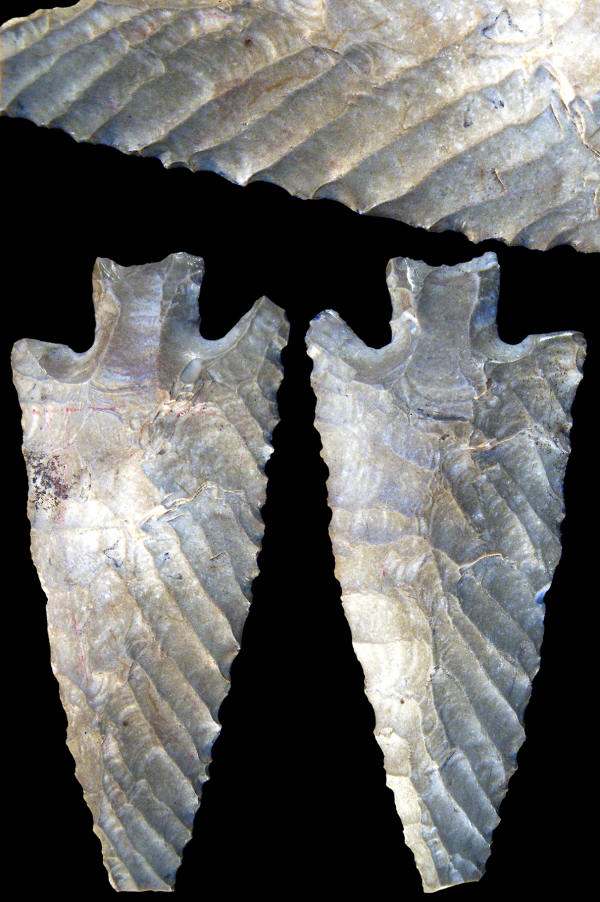
CLICK ON PICTURE FOR LARGER IMAGE
SAWMILL POINT
LOWE RANCH
LATE ARCHAIC
NORTHERN BELIZE
This Sawmill point was illustrated by
Kelly in 1993. It was complete when it was illustrated but
apparently lost its tip sometime later. It was found on the Lowe
Ranch in northern Belize. A paper published in 2006 (Lohse) suggests
that Sawmill points may be less common than Lowe points. According
to current data, their distribution area in northern and western
Belize also seems to be smaller. As can be seen in this
picture, Sawmill point's most sticking features are their fine
parallel oblique flaking along the edges and "fluted" expanding
stems. This point is made of Colha chert and measures 2 13/16 inches
(7.2 cm) long. |
|
|
The most recently
reported age range for Lowe points is mainly based on two radio carbon
dates that were taken from the Ladyville site and the Pulltrouser site.
Both sites are in northern Belize. The Ladyville charcoal sample came
from an exposed hearth where two in situ Lowe points were found within a 5 meter
radius of the sample.
Another charcoal sample was taken from the Pulltrouser site where
another Lowe point was found nearby. The average of the radiocarbon
dates suggests that Lowe points date somewhere between 4,500 and 3,900
years. |
|
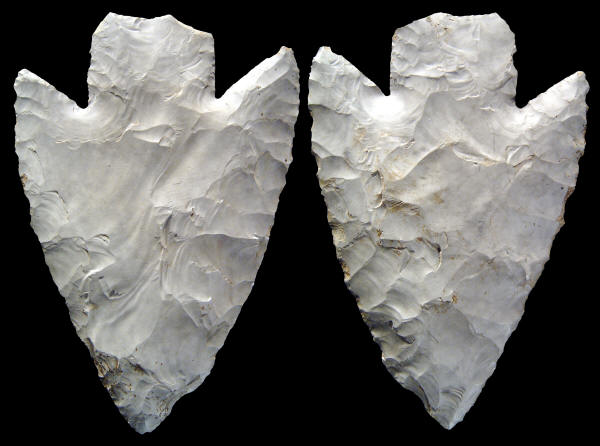
LOWE POINT
LATE ARCHAIC
NORTHERN BELIZE
This Lowe point is reported to be from
northern Belize. It's an excellent and "classic" example of these
large wide points. The most impressive feature is its well defined
and massive barbs. Remnants of the original flake surfaces seem to
be present on both sides. This point doesn't seem to have been
resharpened more than once. The tip of the point apparently needed
repairing from a minor impact. One of the basal corners appears to
be broken but the edge surface is original outer cortex surface, so
maybe not. This point is made of Colha chert and it measures 3 5/8
inches (9.2 cm) long and 2 7/16 inches (6.2 cm) wide. |
|
|
Lowe points are
curiously similar, in some technological ways, to the very much older
Hardin Barbed points that occur more than 2,000 miles north of Belize in
the U.S. They are both resharpened by beveling the edges and the stems
are ground and sometimes "fluted." Many Hardin Barbed points also have
sharp serrated edges, a similar stem design, wide angled barbs, and can
be thick heavy-duty points. But they are typologically different from
Lowe points. What is interesting is that Lowe points are currently
considered to be approximately 5,000 years younger than Hardin Barbed points.
The concept makes one wonder if there might also be "young" concave
based fluted points found someday in Mesoamerica? |
|
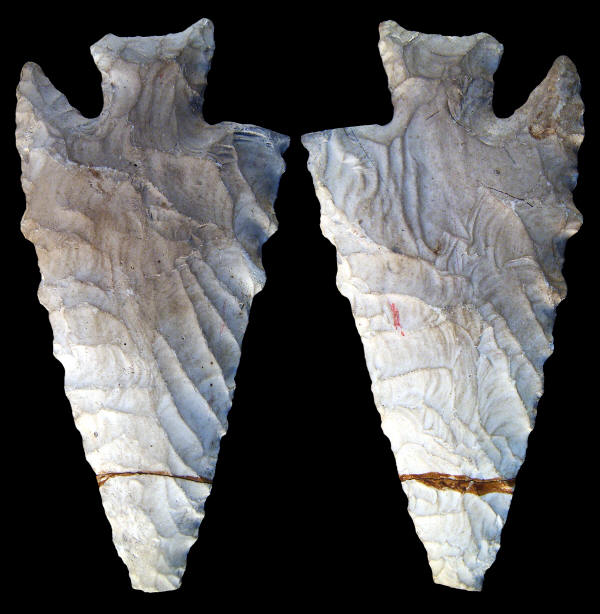
CLICK ON PICTURE FOR LARGER IMAGE
SAWMILL POINT
LOWE RANCH
LATE ARCHAIC
NORTHERN BELIZE
This Sawmill point was illustrated in
Kelly's 1993 report. It was found on the Lowe Ranch in northern
Belize. This point exhibits all the distinguishing traits of a
Sawmill point. The base is corner notched with an expanding stem
that is ground and thinned. The edges are also resharpened with
parallel oblique flaking that are long enough to leave only slightly
beveled edges. This point is made of Colha chert and it measures 3
3/16 inches (8.1 cm) long. |
|
|
The other projectile point type that is
unique to Belize is the Sawmill point. Their most striking feature is
the fine parallel oblique pressure flaking
that is long and wide enough to leave only slightly beveled edges.
Their concave and expanding stems are
also sometimes thinned with long narrow flake removals. Only one Sawmill
point is reported to have been found in situ during excavation. A paper
published in 2006 (Lohse) suggests that Sawmill points may be less
common than Lowe points. According to current data, their distribution
area in northern and western Belize also seems to be smaller. Delicately flaked end-scrapers are also reported to
have been found with Sawmill points. |
|
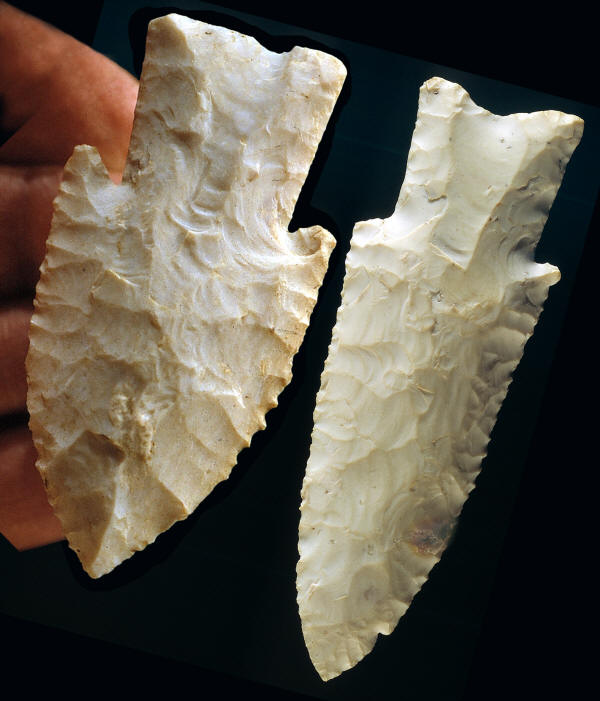
HARDIN BARBED POINTS
EARLY ARCHAIC
SOUTHERN ILLINOIS AREA
Although Hardin Barbed points are found more than 2,000 miles north
of Belize and are not typologically the same as Lowe points, they
are curiously similar, in some technological
ways. A good
percentage of them have basally thinned or fluted stems. The stems
are also ground along the edges. The bases can be widely corner
notched with barbs that are large and wide. The edges will also
often be sharp and serrated. It's interesting that Lowe points are
currently dated as much as 5,000 years younger than Hardin Barbed points. |
|
|
It really is amazing
that the U.S. has so many different types of projectile point styles but
none that match the unique styles of Lowe and Sawmill points. Their
flake removal technology is exceptional. They were made by craftsmen who
were applying a high level of skill in the manufacture of their tools.
There is no doubt that the quality of manufacture of Lowe and Sawmill points are very impressive to
people who understand lithic technology. |
|
"REFERENCES"
1983, Turner II, B. L., & Harrison,
Peter D., "Pulltrouser Swamp: Ancient Maya Habitat, Agriculture, And
Settlement In Northern Belize."
1985, Perino, Gregory, "Selected Preforms, Points And Knives Of The
North American Indians."
1987, Justice, Noel D., "Hardin Barbed Cluster," Stone Age Spear
And Arrow Points Of The Midcontinental And Eastern United States.
1993, Kelly, Thomas C., "Preceramic Projectile Point Typology In
Belize,"
Ancient Mesoamerica, Vol. 4, No. 2.
1996, Brian M. Fagan (Editor in Chief), " The Oxford Companion To
Archaeology..
1997, Kowalewski, Stephen A., "Ancient Mesoamerica: A Comparison Of
Change In Three Regions."
2006, Lohse, Jon C., Awe, Jaime, Griffith, Cameron, Rosenwig, Robert M., & Fred
Valdez, Jr., "Preceramic Occupations In Belize: Updating The
Paleoindian And Archaic Record," Latin American Antiquity, Vol.
17, No. 2.
2010, Evans, Susan Toby & Webster David L., "Archaeology Of Ancient
Mexico And Central America."
|
|
RECENT
LISTINGS HOME
ORDERING |